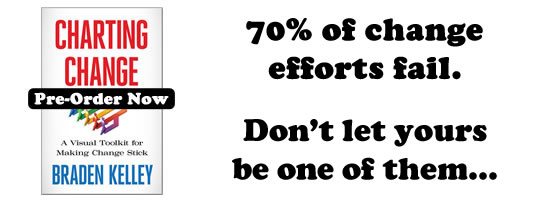To Adapt, We Need To Evolve
 When scientists decoded the human genome in 2001, they found something astounding. While our DNA provides the blueprint for everything about us—from how we develop in the womb to eye color and personality traits—it takes only 20,000 genes to do so, less than one fifth of what had previously been thought.
When scientists decoded the human genome in 2001, they found something astounding. While our DNA provides the blueprint for everything about us—from how we develop in the womb to eye color and personality traits—it takes only 20,000 genes to do so, less than one fifth of what had previously been thought.
What was even more mindblowing was the reason that they had been so off the mark. While our genome would seem to be the model of efficiency, squeezing all that information into a microscopic nucleus, 98% of our DNA is “junkâ€Â that doesn’t code for anything. How could our biology be so wasteful?
In The Selfish Gene, the eminent biologist Richard Dawkins explains that the confusion arises because we assume that DNA exists for our sakes rather than the other way around. We, he argues, are mere vehicles to propagate genes. Much the same can be said about ideas in an enterprise. All too often, we fail to recognize what our business’s DNA is telling us.
The Purpose Of An Enterprise
Chester Carlson was a prototypical inventor. Self taught and brilliant, he worked for years tinkering with his invention even while holding down a day job and going to law school at night. After a decade or so, he finally teamed up with the Haloid Corporation, whose President, Joe Wilson, came up with a plan to market the machines through leases.
It proved to be a billion dollar idea and the firm, which subsequently changed its name to Xerox, became a money machine that grew by leaps and bounds. As the company evolved from a startup to an icon of American industry, it attracted a cadre of top executive talent that continued to hone its business model to optimize efficiency and maximize profits.
Unfortunately we all know how the story ends. As Xerox’s management continued to oil its money machine, the world passed it by. Although it continued to break profit records through the 1970’s, by the 1980’s the firm found itself making products that nobody wanted, albeit more efficiently than ever before.
Xerox had fallen victim to the profit paradox. The purpose of an enterprise is never profit, although profit is what makes it possible for an enterprise to achieve its purpose. The trick is to understand that the DNA of a company, just like the DNA of a biological organism, wants to adapt.
Going Viral
In 1970, Xerox CEO Peter McColough sought to inject new DNA into the company. His vision was to evolve the firm beyond its roots as a copier company and learn to “control the architecture of information.†To that end, he created the Palo Alto Research Center (PARC) and staffed it with the best minds in the emerging field of computer science.
Unfortunately, where McColough saw recombinant DNA that could help his enterprise adapt, the rest of the organization saw an antigen—a foreign species that threatened the biology of the organism—and rejected it. Like an infection exposed to a vigorous immune system, as the ideas coming out of PARC entered the firm’s bloodstream they were immediately attacked.
Yet much like Dawkins’ selfish genes, ideas within an organization exist for their own sakes. While Xerox largely inoculated itself from the viral ideas emanating from PARC, the infection still spread. Its DNA went on to thrive in other biologies and created completely new organisms, such as Apple’s Macintosh, Microsoft’s Office Suite, 3Com, Pixar and others.
John Sculley, the former CEO of Apple, said of the events that took place at Xerox, “I don’t ever want a PARC… All of the technology leaked out.†He was right, of course, but then again Apple wasn’t able to innovate effectively during his tenure and, before long, his company was in the same boat as Xerox, a once-great enterprise peddling yesterday’s products.
Creating Ecosystems
We tend to think of ourselves as one homogenous unit with DNA at the center, but that’s not really true. In fact, our bodies house ten times as many bacterial cells as human ones. Scientists have very little idea what all those little guys are doing, but clearly a lot of it is essential to keep our bodies functioning well.
Truly innovative companies work largely the same way. Instead of creating an overactive immune system of bean counters and other minders to root out anything even remotely foreign, they actively promote internal ecosystems like IBM Research and Google X, where DNA can recombine and create myriad adaptations for an unknown future.
Others actively participate in open source communities, where ideas are freely shared, modified and released to the world.  Still others, like Cisco, routinely acquire startups to continually inject new DNA into their corporate organisms. Ideas are all around and there are countless ways to bring them in and let them mix with internal ecosystems.
All of this comes at a cost. In fact, some innovations end up killing the host. Yet the businesses that survive over the long term are willing to risk it, knowing that the alternative is certain death. In an age of disruption, the only viable strategy is to adapt and to do that, you have to evolve.
The Usefulness Of Useless Things
We call non-coding DNA “junk†because doesn’t contribute to our body’s function. Some of it plays a regulatory role, but most of it just sits there, surviving because of the work of its neighbors. When cells prosper and grow, they divide, propagating the essential genes along with all of the other random code.
Yet scientists are beginning to suspect that our junk DNA performs an evolutionary function. All that raw material sitting in our chromosomes is, in effect, a genome in waiting, ready to help us adapt to changes in our environment. Sure, it doesn’t do much for us now, but our junk DNA is just a few random mutations away from becoming something important.
The truth is that seemingly useless things have a way of becoming useful in time. Context matters. The innovations at PARC were indeed useless for a copier company, but absolutely essential to the computer industry that was just beginning to emerge. In much the same way, the work done at Google X is unrelated to its search business, but may be crucial to its future.
I think that’s what Mark Zuckerberg meant when he wrote, “we don’t build services to make money; we make money to build better services.†From a typical investor’s perspective that may be apostasy, but from the perspective of Facebook’s corporate organism, it’s a strategy that will allow it to evolve, adapt and prosper.
It’s become fairly common for executives to reject ideas because they say, “it’s not in our DNA,†but that is a misapprehension of what DNA is and what it does—evolve. It wants to adapt, because it wants to survive. If we want to survive too, we need to listen to what it is telling us.
“The next big thing will start out looking like a toy,†writes Chris Dixon. In other words, it’ll look like junk.
Wait! Before you go…
Choose how you want the latest innovation content delivered to you:
- Daily — RSS Feed — Email — Twitter — Facebook — Linkedin Today
- Weekly — Email Newsletter — Free Magazine — Linkedin Group
 Greg Satell is a popular speaker and consultant. His first book, Mapping Innovation: A Playbook for Navigating a Disruptive Age, is coming out in 2017. Follow his blog at Digital Tonto or on Twitter @Digital Tonto.
Greg Satell is a popular speaker and consultant. His first book, Mapping Innovation: A Playbook for Navigating a Disruptive Age, is coming out in 2017. Follow his blog at Digital Tonto or on Twitter @Digital Tonto.
NEVER MISS ANOTHER NEWSLETTER!
LATEST BLOGS
Three things you didn’t know about credit cards
Photo by Ales Nesetril on Unsplash Many of us use credit cards regularly. From using them for everyday purchases to…
Read MoreFive CV skills of a business-minded individual
Photo by Scott Graham on Unsplash The skills listed on a CV help employers quickly understand your suitability for a…
Read More


